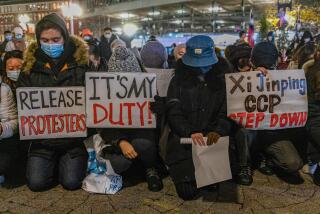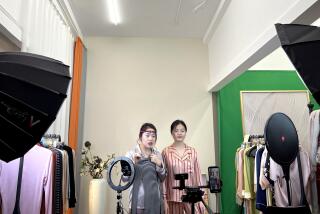Chinese Boom Brings Foreign Companies Back : Commerce: Many firms had backed away after the crackdown on the democracy movement in 1989.
- Share via
BEIJING — Three years after troops crushed the democracy movement on Tian An Men Square, foreign businesses are flocking back into China, lured by a booming economy and increasingly open market.
In one recent week alone, Procter & Gamble Co. President John Pepper, Shell Oil Co. Chairman John Jennings and David John, executive director of Inchcape Group PLC, a London-based multinational trading company, were in China to meet top leaders and explore business opportunities.
“Things are certainly picking up from post-June, 1989, days and significantly from last year,” said Helena Kolenda, an American lawyer who advises foreign firms and helps negotiate contracts.
“There are times I feel like I’m going to sink,” she said of the heavy workload.
When Chinese tanks rolled into Beijing’s streets in June, 1989, to put down student-led protests for a freer society, most foreign businessmen hopped planes to Hong Kong. They came back in a few weeks, but the lingering image of chaos caused a sharp falloff in investment from the West, especially from the United States.
That has changed over the past year, due largely to China’s improved treatment of foreign investors and confidence that its rapid economic growth will continue.
A record 8,926 foreign investment projects won Chinese government approval in the first five months of 1992, more than 15% of the total since China began allowing foreign investment in 1978.
The foreign investment pledged for those projects totaled $10.45 billion, 2.7 times that of the same period last year.
The government has loosened restrictions that kept most foreign manufacturers from selling to China’s 1 billion consumers. Western labels like Lux soap, Head and Shoulders shampoo, Heinz baby food and Pabst Blue Ribbon beer can now be found on many shop shelves.
More foreign companies are being allowed to invest in the retail sector. Japan’s Yaohan International Group, for example, signed a contract in June to open a joint venture store in Shanghai.
Under U.S. pressure, China has strengthened its protection of international property rights and began publishing trade-secret rules.
China also has taken steps toward conforming with free-market principles in foreign trade in hopes of being admitted to the General Agreement on Tariffs and Trade.
But the biggest draw is China’s buoyant economy, one of the fastest growing in the world. In the first five months of this year, the gross national product grew 11%, compared to the same period in 1991--to about $145 billion. Industrial production rose 18% and retail sales nearly 14%.
The latest trade figures show that China had a $1.8-billion surplus in August.
American investment has rebounded despite the threat that the U.S. Congress might cancel China’s low-tariff trade status. Congress has tried repeatedly to do so in response to China’s human rights record but always falls a few votes too short to override President Bush’s sure veto.
New U.S.-contracted investment this year might top the previous high of $645 million in 1989, most of which was pledged before the military crackdown.
A recent survey by Hong Kong’s American Chamber of Commerce found that 97% of the 405 member companies polled described China’s investment climate as favorable or very favorable. They cited the growing economy, expanding domestic market and stable political climate.
“There are very few people today who worry about economic reform. Most of us feel that economic reform is irreversible,” said Michael Lung, Dow Chemical Co.’s general manager for China and Hong Kong. “The debate (in China) is not whether economic reform will go or not go, it’s how fast and by what route.”
Dow has invested $55 million in a new joint venture plant to produce 20,000 metric tons of polyol annually. Polyol is used in mattress foam and car seats.
Among other major new investors:
* French auto maker Citroen recently set up China’s largest joint venture to produce 300,000 cars annually.
* Honda Motor Co., the world’s top motorcycle maker, plans to launch a joint venture this summer to manufacture at least 50,000 motorcycles a year.
* American electronics giant Motorola Inc. is building a $120-million factory to produce semiconductors, cellular phones, radio paging systems and computer software.
* An Amoco Petroleum Corp. subsidiary signed a contract in May for on-shore oil exploration.
More to Read
Inside the business of entertainment
The Wide Shot brings you news, analysis and insights on everything from streaming wars to production — and what it all means for the future.
You may occasionally receive promotional content from the Los Angeles Times.










